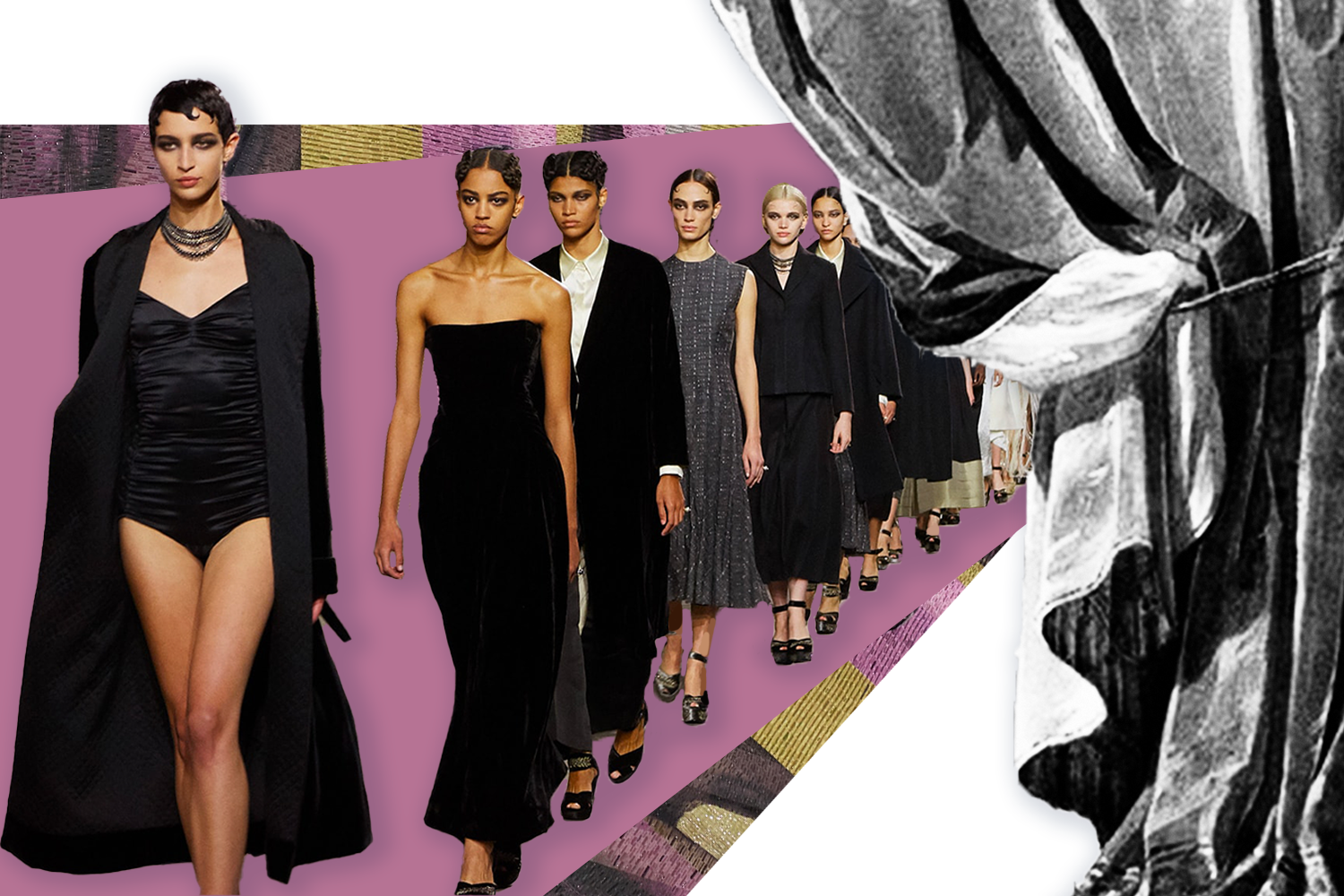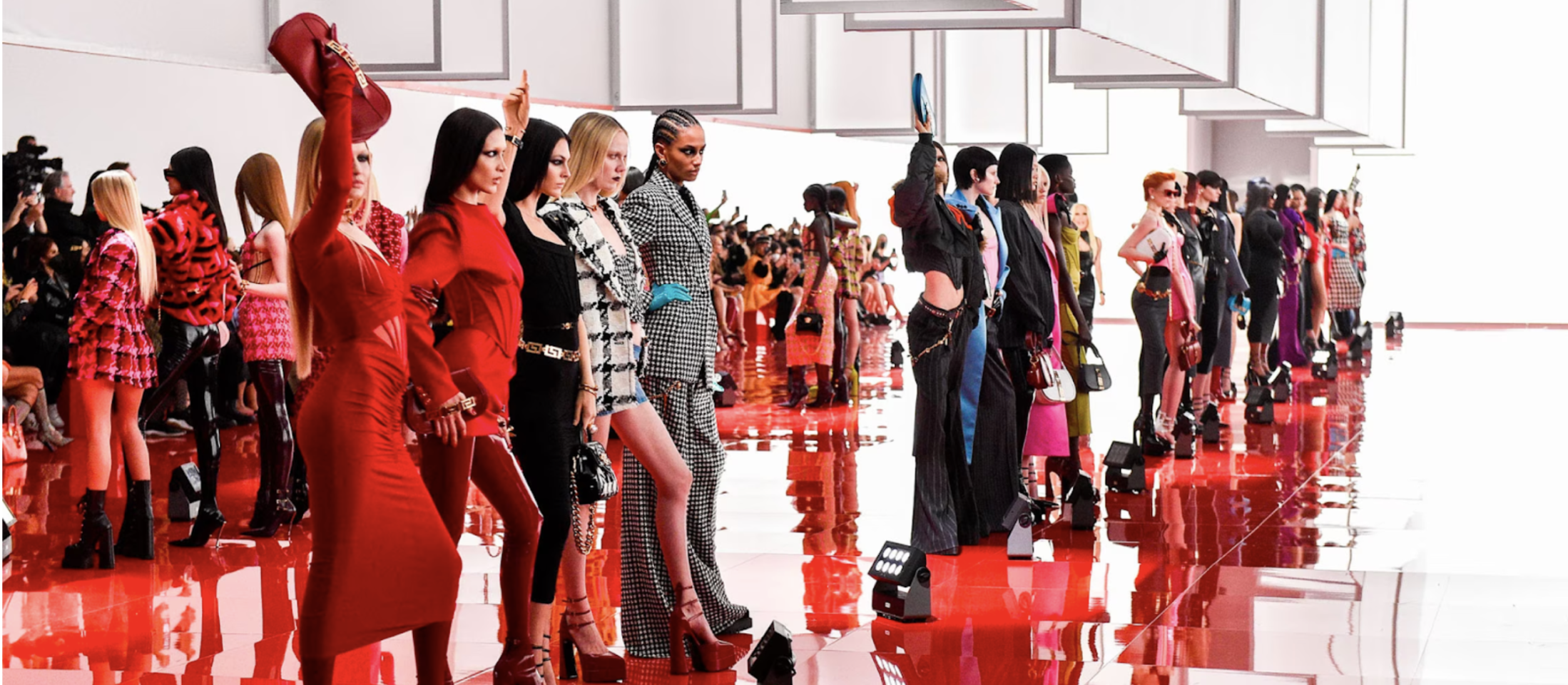The Runway is a Theater and Models are its Muse
Graphic by Ruth Ellen Berry.
Ever since Versace released their F/W22 collection at Milan Fashion Week, I haven't stopped thinking about how much modeling and runways have changed since the 90s. Versace represents a minority today where the runway is an extension of the art of fashion through the performance put on by the models. In the 90s, runway performances were common. Designers encouraged their models to saunter down the runway to bring life and a story to the clothes they were showing to the world. As a result, models had a powerful influence in the fashion world. They were capable of showing how confident consumers of the brands they walked for would feel wearing those clothes, while also demonstrating the wearability and practicality of the clothes through their movement. Models became known as celebrities off the stage: supermodels.
Versace F/W 22 closing. Image courtesy of Versace.
The origin of the title ‘supermodel’ differs depending on which source you look at. Some will say Lisa Fonssagrives, who modeled from the 30s-50s, was the first supermodel while others argue Janice Dickinson, a model from the 70s-80s was the first because she coined the term herself. Whoever it was, supermodels had a huge influence on fashion and culture during the mid to late 1900s. Outside of modeling, they were high profile celebrities who starred in movies, went on talk shows and were famous enough to be known by their first names alone. A significant contributor to their fame was their walk.
Models during the 90s developed their signature walks. Naomi Campbell and Shalom Harlow have some of the best runway walks to this day. They exude a confidence, power, drama and glamor that matched the clothes they were in. Without bringing too much attention to themselves, they did not allow the clothes to wear them. Instead, they brought the connection they had with the clothes to the runway.
Today, the opposite is true. Models bring no drama to the clothes they wear at shows, and instead, allow the clothes to wear them. This isn’t completely the models’ fault, though. The designers have a role in how they want their models to walk. Models who walked for Dior when John Galliano was the creative director were told to be dramatic and excessive on the runway. He wanted his models to tell a story and share his vision with his audience. Shalom put on a spectacular and iconic performance at Alexander McQueen’s S/S99 show where her dress was painted by two robot arms. And who could forget when Niki Taylor revved the handles of her motorcycle corset by Thierry Mugler? Performance was inseparable from fashion in the 90s.
Alexander McQueen S/S 99. Image courtesy of MediuM.
Mugler S/S 92. Image courtesy of Vogue.
To dissect this shift from modeling in the 90s to today, it’s important to keep in mind how fashion itself has changed since the 90s. The disappearance of the supermodel and runway performance corresponds with the more minimalist approach designers are now taking with their clothes. As a result, models are told to bring no attention to themselves so that all focus can be on the clothes. It’s hard to be anything other than expressionless when modeling plain clothes in mute colors, so, models now simply walk across a runway. With the performance element gone and the focus designers had on telling a story, whether through maximalism, grunge, or otherwise, fashion, especially in the top brands, has become very one-note and unremarkable.
Minimalism is being used by designers as reasoning to focus on structure, wearability and longevity in their clothes. However, this is a weak argument as consumers expect luxury brands to be tailored, wearable and long-lasting for how much they are paying. High quality and attention to detail is the bare minimum. Of course it’s different when a brand’s ethos is minimalism, like The Row, however brands that have long histories of always bringing an element of drama to their runways, clothing and modeling, this approach starts to translate into laziness.
Are they so complacent with their place at the top of the business that they believe creativity is no longer needed to keep consumers interested? Has the brand become so consumed by commercialism that they forget what fashion means and represents? Either way, the boredom currently infecting the fashion industry has invaded modeling, turning the field from fashion’s stage to fashion’s mannequin.
Dior S/S 23 Haute Couture. Image courtesy of Dior.
It is also important to notice how runways themselves have changed. Runways were usually built in a straight line where models would appear from being a wall at the end of the runway and walk down to the front, pose at the end and walk back to the wall. Today, runways have morphed to elaborate designs and, even if they are straight lines, they are in complex paths. Balenciaga, for example, had a runway modeled after a snowstorm. Karl Lagerfield, the former creative director for Chanel, had iconic runway designs. One featured his models walking in a supermarket. Louis Vuitton’s F/W22 show was a complex path runway. While I was watching it, I tried to follow where the models were going and had to leave the video because I was so confused. The increased complexity of physical runways may compensate for the lack of performance from models and the repetitive clothes. However the runway is nothing more than a stage. What is the point of a stage if there is no one to perform on it?
Chanel F/W 14. Image courtesy of The New York Times.
In conclusion, drama on the runway is dead. Not quite. There are models today who have made their mark on the industry and even in pop culture by bringing back the art of performance to the runway. One of these is Leon Dame.
Leon Dame is a 20-year-old male model from Berlin who was scouted while waiting at a bus stop. His first show was in 2016, and since then Dame has made a name for himself as a successful male model. He caught the eye of John Galliano, who is now creative director at Maison Margiela after being dismissed from Dior in 2011, because of his dramatic and powerful walk. He gave a stunning performance in 2019 when he walked for Maison Margiela, but it wasn’t until he closed for the fashion house at Paris Fashion Week in 2019 that he was catapulted to fame. Dame stole the attention of the entire audience and the internet as he fiercely stomped down the runway and struck a pose before prancing back up the runway and backstage. In 2020, Dame proved he was able to give clothes the personality and drama they required by changing his walk from intimidating and powerful, to graceful and delicate. At Paris Fashion Week, Dame walked for Margiela again for the F/W23 collection, and again showed his ability to embody the message the clothes portrayed in his walk, breathing life into an already interesting collection.
Leon Dame for Maison Margiela F/W19. Image courtesy of British Vogue.
Leon Dame for Maison Margiela S/S19, HC S 22, F23. Images courtesy of British Vogue and Vogue.
Dame isn’t the only model returning to the theatrics of modeling. Sofia Steinberg, known for her fierce gaze and aggressive walk, Bella Hadid, arguably the industry’s newest supermodel, the new Mugler squad, and Schiaparelli and Versace as brands are all holding fast to modeling as an art form. None are complacent with their position in fashion, even though most of them have enough of a name to slip into complacency. Instead, all recognize that fashion is an art form that communicates something about the designer, the way they view the world, and the way models interpret that on the runway.
The idea of minimalism in both fashion and modeling as a tactic to draw in more consumers is beginning to backfire. It is more and more apparent that the new generation of luxury consumers want to see more from these brands. Creativity, passion and boldness are sought after more than ever in a time where authenticity is highly valued. Models who reflect that authenticity and designers who allow them to are the ones who will stand the test of time and will be memorialized forever.








